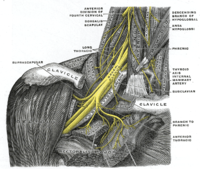
Response to the letter to the editor concerning: “Change in shoulder external rotation strength and motion after lower trapezius transfer to the infraspinatus in children with obstetric brachial plexus palsy”
Sign Up to like & getrecommendations! Published in 2022 at "International Orthopaedics"
DOI: 10.1007/s00264-022-05332-1
Abstract: We appreciate Dr. F Özden’s [1] comments regarding our article titled “Change in shoulder external rotation strength and motion after lower trapezius transfer to the infraspinatus in children with obstetric brachial plexus palsy” [2]. We… read more here.
Keywords: strength; external rotation; lower trapezius; brachial plexus ... See more keywords

Cocontraction measured with short-range stiffness was higher in obstetric brachial plexus lesions patients compared to healthy subjects.
Sign Up to like & getrecommendations! Published in 2017 at "Journal of biomechanics"
DOI: 10.1016/j.jbiomech.2017.08.015
Abstract: We suggest short range stiffness (SRS) at the elbow joint as an alternative diagnostic for EMG to assess cocontraction. Elbow SRS is compared between obstetric brachial plexus lesion (OBPL) patients and healthy subjects (cross-sectional study… read more here.
Keywords: range stiffness; brachial plexus; cocontraction; short range ... See more keywords

Risk factors for persistent disability in children with obstetric brachial plexus palsy
Sign Up to like & getrecommendations! Published in 2017 at "Journal of Perinatology"
DOI: 10.1038/jp.2016.195
Abstract: Objective:Obstetric brachial plexus palsy (OBPP) at birth, is a serious neurologic injury that may lead to a long lasting disability. We aimed to examine the occurrence and risk factors associated with disability lasting >1 year.Study… read more here.
Keywords: disability; year; brachial plexus; risk factors ... See more keywords

Resolving Co-contraction of the Elbow in Patient with the Sequelae of Obstetric Brachial Plexus Palsy: A Cohort Study.
Sign Up to like & getrecommendations! Published in 2023 at "Plastic and reconstructive surgery"
DOI: 10.1097/prs.0000000000010397
Abstract: BACKGROUND Obstetric brachial plexus palsy (OBPP) can cause deformities of the upper extremity in up to 92% (S-OBPP). Reconstruction of the elbow is difficult because co-contraction of the elbow flexor (EF) and extensor (EE) muscles… read more here.
Keywords: brachial plexus; plexus palsy; contraction; contraction elbow ... See more keywords

Increased incidence of shoulder dystocia but a declining incidence of obstetric brachial plexus palsy in vaginally delivered infants
Sign Up to like & getrecommendations! Published in 2022 at "Acta Obstetricia et Gynecologica Scandinavica"
DOI: 10.1111/aogs.14481
Abstract: Obstetric brachial plexus palsy (OBPP) is a serious form of neonatal morbidity. The primary aim of this population‐based registry study was to examine temporal trends, 1997–2019, of OBPP in infants delivered vaginally in a cephalic… read more here.
Keywords: incidence; brachial plexus; obstetric brachial; plexus palsy ... See more keywords

Clavicular fracture in the newborn: Is fracture location a risk factor for obstetric brachial palsy?
Sign Up to like & getrecommendations! Published in 2018 at "Journal of neonatal-perinatal medicine"
DOI: 10.3233/npm-181728
Abstract: BACKGROUND The incidence of clavicle fracture in the newborn population ranges from 0.2 to 3.5% with an associated rate of obstetric brachial palsy (OBP) ranging from 4 to 13% . METHODS The aim of this… read more here.
Keywords: location; fracture; brachial palsy; fracture newborn ... See more keywords